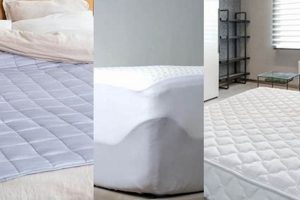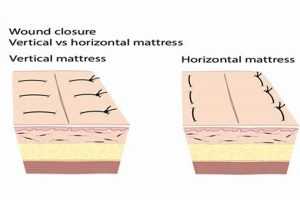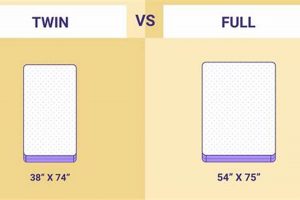The dimensional variances between standard queen and king-sized mattresses represent a significant consideration for individuals selecting bedding. A queen mattress typically measures 60 inches wide by 80 inches long, while a king mattress expands to 76 inches wide by 80 inches long. This 16-inch difference in width has implications for sleeping space and bedroom aesthetics.
These mattress dimensions directly impact sleep quality, particularly for couples or individuals who appreciate ample personal space. The broader surface of the king offers more room for movement and minimizes sleep disruption caused by a partner. Historically, the evolution of mattress sizes reflects societal shifts toward larger homes and a greater emphasis on individual comfort within the domestic environment.
A detailed examination of these size variations reveals their practical implications. Factors such as bedroom size, sleeping arrangements, and individual preferences become crucial determinants in the selection process. The ensuing discussion will explore these considerations, providing a comprehensive guide to navigating the choice between these two popular mattress sizes.
Considerations for Selecting Mattress Dimensions
The selection of appropriate mattress dimensions necessitates a thorough assessment of individual needs and environmental constraints. The following considerations should inform the decision-making process.
Tip 1: Assess Bedroom Size: Prior to purchase, measure the available floor space within the bedroom. Ensure adequate room for movement around the bed and other furniture. A king-sized mattress may overwhelm a smaller bedroom, creating a sense of confinement.
Tip 2: Evaluate Sleeping Partners: If sharing the bed, consider the sleeping habits of both individuals. A king-sized mattress provides significantly more personal space, potentially mitigating sleep disturbances caused by movement or differing sleep schedules.
Tip 3: Account for Budget: Mattress prices vary substantially. King-sized mattresses typically command a higher price point than queen-sized mattresses. Factor this cost differential into the overall budget.
Tip 4: Consider Bedding Availability: Bedding, such as sheets and comforters, must correspond to the mattress dimensions. King-sized bedding tends to be more expensive and potentially less readily available than queen-sized options.
Tip 5: Assess Transport and Setup: The larger dimensions of a king-sized mattress may present challenges during transport and setup. Ensure accessibility through doorways and stairwells.
Tip 6: Consider Frame Compatibility: The existing bed frame must be compatible with the chosen mattress size. Verify that the frame provides adequate support and dimensions for either a queen or king-sized mattress.
The aforementioned considerations aim to facilitate a well-informed decision. By carefully evaluating these factors, individuals can optimize their sleep environment and ensure long-term satisfaction with their mattress selection.
The subsequent section will address additional elements related to the long-term care and maintenance of mattresses, further extending the lifespan and utility of this essential furnishing.
1. Width Accommodation
Width accommodation, in the context of mattress selection, refers to the spatial provisions afforded by a mattresss width for one or more sleepers. This consideration is paramount when evaluating the suitability of “queen vs. king mattress measurements” for individual needs and preferences.
- Individual Sleeper Space
Width directly impacts the personal space available to each sleeper. A queen mattress, measuring 60 inches wide, provides approximately 30 inches of space per person when shared. A king mattress, at 76 inches wide, offers 38 inches per person, a substantial increase that reduces the likelihood of sleep disruption due to partner movement or differing sleep positions. This consideration is particularly relevant for individuals accustomed to ample personal space or those who tend to move frequently during sleep.
- Pet Accommodation
The presence of pets in the bed further necessitates consideration of width. Pets, particularly larger breeds, can occupy a significant portion of the sleeping surface, reducing the available space for human occupants. A king-sized mattress provides greater flexibility in accommodating pets without compromising the comfort of human sleepers. The added width becomes a practical advantage in households where pets are integral members of the sleeping arrangement.
- Edge Support Considerations
While not directly related to the overall width measurement, edge support plays a crucial role in maximizing the usable width of the mattress. Mattresses with weak edge support may compress excessively when weight is applied near the perimeter, effectively reducing the sleeping surface. This phenomenon can be more pronounced on a queen-sized mattress due to its smaller overall dimensions. Selecting a mattress with robust edge support ensures that the stated width is fully and comfortably accessible.
- Sleep Position Preferences
Individuals who prefer to sleep on their backs or stomachs often require more width than those who sleep in a fetal position or on their sides. Back and stomach sleepers tend to spread out more, necessitating a wider sleeping surface to maintain comfort and prevent feelings of confinement. A king-sized mattress may be a more suitable choice for these sleep positions, particularly for couples where at least one partner prefers to sleep in a position that occupies a larger surface area.
The selection between “queen vs. king mattress measurements” hinges significantly on the assessment of width accommodation. By evaluating individual sleeper needs, the presence of pets, edge support considerations, and preferred sleep positions, individuals can make an informed decision that optimizes their sleep experience and spatial comfort.
2. Bedroom Proportions
The spatial harmony within a bedroom directly influences the perceived comfort and functionality of the environment. Mattress dimensions, specifically the divergence between queen and king sizes, represent a significant determinant of this harmony. An inappropriately sized mattress, relative to the room’s proportions, can negatively impact both aesthetics and usability. For instance, a king-sized mattress placed in a small bedroom, measuring less than 10 feet by 10 feet, may impede movement, restrict access to closet space, and create a sense of confinement. Conversely, a queen-sized mattress in a large bedroom may appear disproportionately small, leaving an impression of emptiness and underutilization of available space. The selection of appropriate mattress dimensions, therefore, necessitates a careful assessment of bedroom dimensions and a consideration of the furniture arrangement.
Effective utilization of space involves not only the mattress itself but also the surrounding elements. Nightstands, dressers, and other furniture pieces must be positioned in a manner that facilitates ease of access and movement. Overcrowding can lead to difficulties in navigating the room, potentially impacting sleep quality and overall well-being. Consider a bedroom measuring 12 feet by 14 feet. A king-sized mattress, occupying a substantial portion of the room, might necessitate smaller nightstands and limit the placement of other furniture, such as a reading chair or desk. A queen-sized mattress, in this scenario, offers greater flexibility in furniture arrangement and may contribute to a more balanced and functional space. Scale drawings or digital room planning tools can assist in visualizing the impact of different mattress sizes on bedroom layout.
In summary, the alignment between mattress dimensions and bedroom proportions is integral to creating a comfortable and functional living space. The potential for spatial disharmony necessitates a thoughtful assessment of room size, furniture requirements, and individual preferences. Careful consideration of these factors will contribute to a more aesthetically pleasing and practically efficient bedroom environment, thereby enhancing the overall quality of life within the home. Balancing mattress size and spatial constraints is a critical step in optimizing the usability and visual appeal of the bedroom.
3. Sleeping Partners
The presence of a sleeping partner introduces a layer of complexity to mattress selection. Individual sleep preferences, coupled with potential disturbances caused by movement, temperature regulation, or varying sleep schedules, necessitate careful consideration of mattress dimensions. The differential in width between queen and king-sized mattresses directly impacts the quality of sleep for both partners. A queen-sized mattress, offering approximately 30 inches of individual space, may prove inadequate for couples who value personal space or experience significant sleep disturbances. Conversely, a king-sized mattress, providing 38 inches of individual space, minimizes the likelihood of involuntary physical contact and reduces the transmission of movement, fostering a more restful sleep environment.
Real-life examples illustrate the practical significance of understanding this connection. Consider a couple where one partner tends to toss and turn frequently during the night. The confined space of a queen-sized mattress may lead to frequent awakenings for the other partner, resulting in fragmented sleep and reduced daytime alertness. Upgrading to a king-sized mattress, with its increased width, can mitigate this issue by providing greater separation and minimizing the impact of movement. Similarly, couples with disparate temperature preferences may benefit from the added space of a king-sized mattress, allowing each individual to regulate their immediate sleeping environment more effectively. The selection process should involve open communication between partners, identifying potential sources of sleep disruption and collaboratively evaluating the suitability of different mattress dimensions. Mattress types that limit motion transfer further enhance sleep quality for couples.
In summary, the interaction between sleeping partners significantly influences the optimal selection of mattress dimensions. The decision between a queen and king-sized mattress hinges on a thorough assessment of individual sleep needs, potential sources of disturbance, and a mutual desire to foster a restful sleep environment. The increased width afforded by a king-sized mattress often provides tangible benefits in terms of reduced sleep disruption and improved overall sleep quality for both partners. Understanding the practical implications of “Sleeping Partners” as a component of “queen vs. king mattress measurements” is, therefore, essential for informed decision-making.
4. Budget Allocation
Budget allocation represents a critical constraint in the selection of mattress dimensions. The decision between queen and king sizes carries significant financial implications, extending beyond the initial purchase price to encompass ancillary costs such as bedding and frame requirements.
- Initial Mattress Cost
The fundamental price differential between queen and king mattresses constitutes the primary budget consideration. King-sized mattresses, due to their increased material requirements, typically command a higher price point than comparable queen-sized models. For example, a high-quality memory foam mattress in a king size may cost 20-50% more than the equivalent queen size. This initial investment should be carefully evaluated against budgetary limitations.
- Bedding Expenses
Subsequent to the mattress purchase, bedding expenses represent a recurring financial commitment. Sheets, comforters, and other bedding accessories specifically designed for king-sized mattresses generally cost more than their queen-sized counterparts. This is directly attributable to the larger surface area and increased material usage. A set of high-thread-count sheets for a king mattress, for instance, could easily exceed the cost of a similar set for a queen mattress by a significant margin. These ongoing costs must be factored into the overall budget.
- Frame and Foundation Considerations
The existing bed frame or the requirement for a new foundation introduces another element to budget allocation. A king-sized mattress necessitates a robust and appropriately sized frame to ensure adequate support and prevent premature wear. If the current frame is incompatible, the additional expense of acquiring a suitable king-sized frame must be considered. Moreover, the structural integrity of the floor may need assessment, particularly in older homes, to accommodate the increased weight of a king-sized mattress and frame.
- Transportation and Setup Costs
The larger dimensions and increased weight of a king-sized mattress can elevate transportation and setup costs. Professional delivery services may charge higher fees for handling king-sized mattresses, particularly if stairwells or other logistical challenges are involved. Additionally, self-transportation may necessitate renting a larger vehicle or enlisting assistance, incurring further expenses. These logistical considerations should be incorporated into the overall budget assessment.
The interplay between these budget facets and “queen vs. king mattress measurements” necessitates a comprehensive financial evaluation. The long-term costs associated with each size option should be carefully weighed against budgetary constraints and individual priorities. While the increased sleeping space offered by a king-sized mattress may be desirable, the corresponding financial implications must be thoroughly understood and accommodated within the allocated budget.
5. Bedding Costs
The dimensional disparity between queen and king mattresses directly influences the associated costs of complementary bedding. This represents a significant budgetary consideration when choosing between these two mattress sizes. King-sized bedding, characterized by its larger surface area, inherently requires more fabric and materials during manufacturing, leading to elevated retail prices compared to queen-sized alternatives. This price differential extends across various bedding items, including sheets, comforters, duvet covers, and mattress protectors. For instance, a high-quality, long-staple cotton sheet set for a king mattress may consistently cost 30-50% more than a comparable queen-sized set. This cost escalation stems directly from the increased fabric consumption and more complex cutting and sewing processes involved in producing larger bedding items.
The practical implications of these increased bedding costs are multifaceted. Consumers operating under strict budgetary constraints may find the higher price point of king-sized bedding to be a deterrent, potentially influencing their decision towards a queen mattress despite a preference for the increased sleeping space offered by a king. Conversely, individuals prioritizing luxury and comfort may perceive the elevated bedding costs as an acceptable trade-off for the perceived benefits of a larger sleeping surface. Furthermore, bedding availability can also vary depending on the mattress size. While both queen and king sizes are widely available, specialty fabrics, unique designs, or niche brands may exhibit limited availability in king sizes, potentially restricting consumer choices. The long-term accumulation of these bedding costs should be carefully factored into the overall ownership expense of a mattress, as replacement cycles and stylistic preferences necessitate periodic investments in new bedding sets.
In summary, the correlation between “queen vs. king mattress measurements” and “bedding costs” underscores the importance of comprehensive financial planning when selecting a mattress. The initial purchase price of the mattress itself represents only a portion of the overall cost equation. Ongoing expenses associated with bedding maintenance and replacement can significantly impact the total cost of ownership. Consumers should proactively assess their bedding preferences, budgetary limitations, and long-term financial planning goals to make an informed decision that aligns with both their comfort needs and financial constraints. Addressing these financial aspects beforehand enhances the potential for long-term satisfaction with the selected mattress size.
6. Frame Compatibility
Frame compatibility constitutes a fundamental prerequisite for the proper support and longevity of mattresses. The variance in “queen vs. king mattress measurements” necessitates a corresponding adjustment in bed frame dimensions to ensure adequate structural support and prevent premature mattress degradation.
- Dimensional Correspondence
Precise dimensional alignment between the mattress and frame is paramount. A queen mattress, nominally measuring 60 inches wide by 80 inches long, requires a frame designed to accommodate these specific dimensions. Similarly, a king mattress, at 76 inches wide by 80 inches long, demands a proportionally larger frame. Failure to achieve this dimensional correspondence can result in inadequate edge support, mattress sagging, and accelerated wear. For example, placing a king mattress on a queen-sized frame will invariably lead to overhang and insufficient support, compromising both comfort and mattress lifespan.
- Support Structure Integrity
The frame’s support structure must be capable of bearing the weight of the mattress and its occupants. King-sized mattresses, due to their increased dimensions and material density, generally weigh more than queen-sized mattresses. A frame designed for a queen mattress may lack the structural integrity to adequately support the added weight of a king mattress, potentially leading to frame failure or mattress deformation. Reinforcements, such as additional center supports or heavier gauge materials, may be necessary when transitioning to a larger mattress size.
- Headboard and Footboard Attachment
If the intention is to utilize a headboard and/or footboard, the frame must possess compatible attachment points. Queen and king-sized frames often have differing configurations for headboard and footboard attachment, reflecting the variations in mattress width. Incompatible attachment points can necessitate modifications to either the frame or the headboard/footboard, potentially compromising the structural integrity or aesthetic appeal of the bed. Prior verification of compatibility is essential.
- Platform vs. Foundation Considerations
Platform beds, which eliminate the need for a separate box spring or foundation, require a solid or closely spaced slatted surface to provide adequate support. When selecting between “queen vs. king mattress measurements” for a platform bed, ensure that the platform surface area corresponds appropriately to the chosen mattress size. Insufficient platform coverage can lead to mattress sagging and reduced support, particularly in areas of concentrated weight. Alternatively, traditional frames utilizing a box spring or foundation must be selected with the appropriate dimensions to accommodate either a queen or king mattress and provide the necessary support.
These facets highlight the critical interdependency between frame selection and mattress dimensions. A lack of attention to frame compatibility can negate the benefits of a high-quality mattress, resulting in discomfort, premature wear, and potential structural damage. Therefore, careful consideration of frame dimensions, support structure, attachment points, and platform/foundation requirements is essential when deciding between “queen vs. king mattress measurements”.
Frequently Asked Questions
The following addresses common inquiries regarding the dimensional differences between queen and king-sized mattresses, providing clarity on their implications for sleep and space optimization.
Question 1: What are the precise dimensions of a queen and king-sized mattress, and how do these measurements impact sleeping space?
A queen mattress measures 60 inches in width and 80 inches in length, while a king mattress measures 76 inches in width and 80 inches in length. This 16-inch width difference translates directly into increased personal space for each sleeper, particularly relevant for couples or individuals who prefer ample room to move.
Question 2: How should bedroom size influence the selection between a queen and king mattress?
Bedroom dimensions represent a crucial factor. A king mattress may overwhelm a smaller room, impeding movement and creating a sense of confinement. Careful measurement of the available floor space, accounting for other furniture, is essential to ensure that the chosen mattress size allows for comfortable navigation of the room.
Question 3: Do king mattresses always cost more than queen mattresses, and what are the contributing factors to this price differential?
Generally, king mattresses command a higher price due to the increased material required in their construction. Larger dimensions translate to higher material costs, which are reflected in the retail price. However, promotional offers, brand positioning, and mattress features can influence pricing, and a direct comparison of specific models is advisable.
Question 4: Are special considerations necessary when purchasing bedding for a king-sized mattress compared to a queen-sized mattress?
Bedding, such as sheets, comforters, and duvet covers, must correspond to the mattress dimensions. King-sized bedding typically costs more due to increased fabric usage. Additionally, specialized patterns or materials may exhibit limited availability in king sizes, requiring careful sourcing.
Question 5: Does the weight of a king-sized mattress pose logistical challenges during transportation and setup?
King mattresses are heavier and bulkier than queen mattresses, potentially presenting challenges during transportation, delivery, and setup. Access through doorways and stairwells should be assessed beforehand to ensure a smooth installation process. Professional delivery services may be necessary in certain circumstances.
Question 6: Are all bed frames compatible with both queen and king mattresses, or are specialized frames required?
Bed frames are typically designed for specific mattress sizes. A queen frame will not adequately support a king mattress, and vice versa. Utilizing an incompatible frame can lead to inadequate edge support, mattress sagging, and potential structural damage. Verification of frame compatibility is essential prior to purchase.
These FAQs provide essential insights into the practical implications of “queen vs. king mattress measurements.” Careful consideration of these factors will contribute to an informed decision and optimized sleep environment.
The following section will delve into alternative mattress sizes and their respective advantages, offering a broader perspective on mattress selection.
Conclusion
The preceding analysis has provided a detailed examination of “queen vs. king mattress measurements,” exploring the multifaceted considerations that inform the selection process. Key points highlighted include the dimensional differences between the sizes, their impact on individual sleeping space and bedroom aesthetics, budgetary implications concerning mattress and bedding costs, and the critical aspect of frame compatibility. The information presented aims to equip individuals with the knowledge necessary to make an informed decision, aligning their mattress choice with specific needs and environmental constraints.
The choice between a queen and king mattress ultimately represents a trade-off between spatial considerations, financial resources, and personal comfort preferences. As housing trends evolve and personal preferences shift, the continued evaluation of mattress dimensions remains crucial for optimizing sleep quality and enhancing overall well-being. Thoughtful consideration of the factors discussed will contribute to a more satisfactory and sustainable sleep experience.







